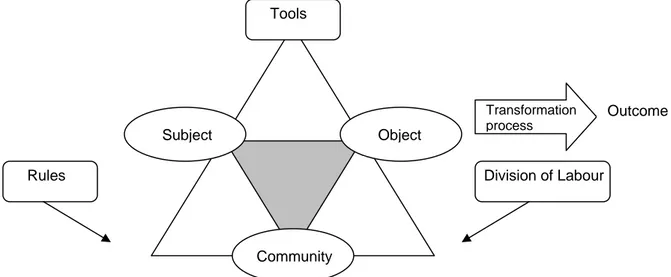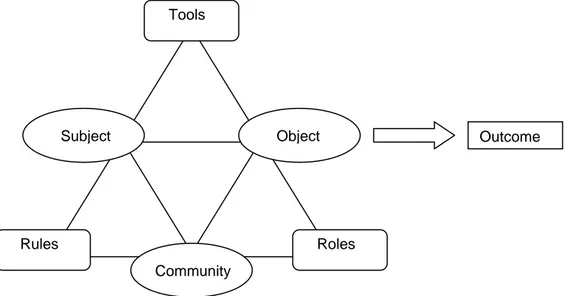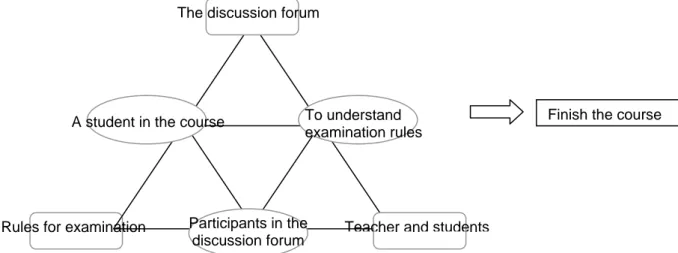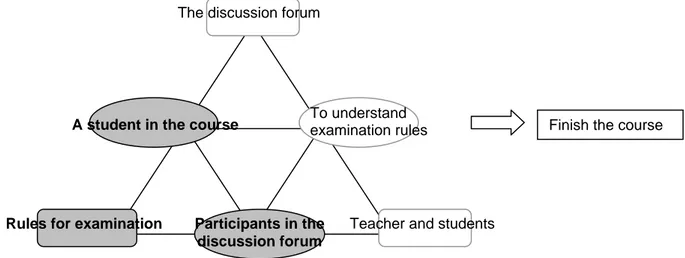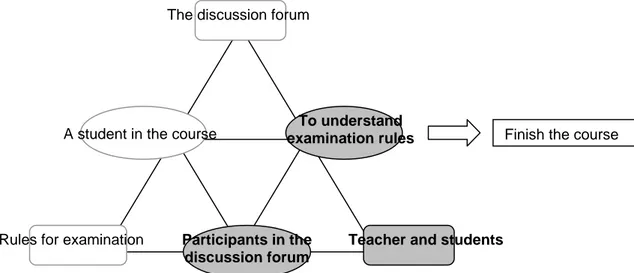ACTIVITY THEORY AS A FRAMEWORK FOR
STUDYING STUDENT INTERACTION AND
KNOWLEDGE CONSTRUCTION IN
A WEB-BASED DISCUSSION FORUM
MARIE MÖRNDAL
School of Business, Mälardalen University SE-721 23 Västerås, Sweden e-mail: marie.mornndal@mdh.se
ABSTRACT
The question of whether Activity Theory can serve as an adequate theoretical framework for research within web-based distance education is analyzed and discussed in this paper. I describe my reflections regarding a comparison with a few different IS approaches, dealt with in the PhD course Fundamental IS Issues. After applying the AT approach on a distance course as a whole and also on a special case, a web-based discussion, I have found Activity Theory to be useful as a holistic and descriptive tool. My conclusions are that Activity Theory provides a language to describe and analyze key features of my research project regarding knowledge construction and interaction in web-based distance education. I have also found Activity Theory to facilitate my aim to find and develop new perspectives according to my research focus.
Keywords: activity theory, web-based learning, collaboration, conflict
1. Introduction
This paper is written as an examination in the PhD course Fundamental IS Issues. Referring to the course syllabus the objective of the course is to develop students’ “comprehension of different scientific,
theoretical and methodological approaches to the analysis of different issues in modern Informatics, and apply theoretical concepts to real-world problems”. In line with this objective the paper will focus on a
“real-world problem” from my own research project. My research interest is within web-based distance education where focus is on students learning processes and knowledge construction on discussion forums [1, 2, 3].
During my research project I have been seeking an adequate theoretical framework to describe and analyze the empirical findings as well as support the development of my future research work. My intention with this paper is therefore two-folded. Firstly I will use this paper as a part of my research project since I recognize this as an ideal opportunity to work through different theoretical approaches in order to
find an appropriate framework for my future research studies. Secondly it is also a part of the examination in the course Fundamental IS Issues, as previous mentioned.
2. The research project
Before I describe and discuss the different theoretical approaches I have considered for building a theoretical framework, I will briefly explain my research project so far. The summary includes an outline of the study object, research design and findings.
2.1. The course
I have studied students, teachers and a Learning Management System (LMS) in a distance course at Mälardalen University. The course was called Introduction to Academic Studies and was part of a one year college program for students interested in university studies but not fully qualified for studies of an academic level. The purpose of the course was to encourage and prepare students for future academic studies. None of the students in the study had any previous experience of university studies, but some of them had studied on a distance basis on a lower educational level. The course was interdisciplinary and aimed to introduce and provide basic knowledge about scientific and critical thinking. It was a part time course, comprising ten Swedish credit points and lasted from November 2004 to April 2005. A LMS called WebCT was used in the course for information and communication between students and teachers.
2.2 Research design
I perceive the study as a case study but also as a pilot study for future research. The object has been to investigate interaction and knowledge construction on a discussion forum. The study has been carried out by making interviews with participating teachers and students and observations of the students’ behaviour and contributions on a discussion forum in WebCT. In addition statistical information about the students’ behaviour on the discussion forum has been retrieved from WebCT. An initial questionnaire was carried out, aimed to explore the students’ attitudes towards their own learning processes. The answers indicated that the students did not expect much support
from each other. Furthermore they showed an ambiguous attitude towards participating in a group, in order to enhance their learning process. Most students perceived their learning achievements to be dependent on their own efforts. The interviews showed the students’ lack of confidence in their own capability to contribute to knowledge construction in a group. The importance of discipline and self-efficiency was mentioned several times among the students as well as among the teachers in the interviews.
2.3 Findings
The findings indicate that students’ attitudes towards knowledge construction and learning processes affected the way they behaved on the discussion forum. I observed that the most visibly active students, who also produced the majority of the postings on the discussion forum, were the most successful students in the course. The study points in the same direction as previous research results regarding prediction of students’ learning outcomes, namely that students’ behaviour on a discussion forum indicates their learning outcomes at the end of a course.
The findings also show that students without any previous experience of university studies are able to support each other in knowledge construction on distance. The LMS, WebCT, with its threaded discussion forum proved to be a relevant tool for developing learning and constructing knowledge, but it does not exclude the teacher’s contribution. The student group in this study was in need of the teacher’s intervention. A possible assumption could be that the less study experienced students the more intervention from a teacher is needed.
The result of my study and my interest in learning and interaction as well as information systems theory have brought me closer to three of different IS theory approaches. These will be discussed in the next section.
3. The appropriate theory framework
During my research project I have searched for an adequate theory framework which could be used as scaffolding, supporting and enabling
me to explain, discuss and go beyond the research problem I am dealing with. In the subsequent section I will discuss the pros and cons regarding the three theory approaches.
3.1. Knowledge Management
The first IS theory approach is Knowledge Management (KM). This seems like an obvious choice dealing with knowledge as I am. Sveiby [4] argues that there are two tracks in KM; the IT-track where knowledge is viewed as objects and the People-track where knowledge is equivalent to processes. The latter is interesting from my point of view because of its process orientation in combination with its ability to deal with knowledge creation and knowledge sharing. After having studied the KM-area I have found it too far and wide to fill the requirements of the scaffolding framework I am looking for. My understanding of KM is that its focus is handling, managing and storing knowledge in organizations. According to Kjellin [5] the problems with knowledge sharing in organizations has been underestimated and difficult to solve. Organizational knowledge is often tacit in contrast to the explicit knowledge which can be found in a university course. Due to these aspects on KM I decided to look for another theoretical approach.
3.2. Systems theory of the Scandinavian school
The second IS theory approach I have found interesting is the Systems Theory of the Scandinavian school. Langefors [6] has developed the Relativity Principle for Systems which he describes as: “Every system which is subject to influence from its environment is a
subsystem of some larger system and every system part is potentially a system” (P 36). If every phenomenon is a system this IS theory
approach can be applied on anything from my waste-paper basket to an advanced enterprise system. In a way this can be an advantage because it will enable me to describe the course as a system including all system parts [7] (students, teacher, learning management system etc.), but when I reflected a bit further and posed the questions; Will it bring new ideas to my study? Will it support my further studies or help me to develop new perspectives according to my research focus? The answer was no, because as I understand, Langefors’ IS theory approach focuses
on the system per se and does not take the possible influences by the environment in consideration. It can be used to describe and analyze the components of a system [7], but it does not cover my requirements of a useful framework because I perceive the environment as an important factor in my research project.
3.3. Activity Theory
The third IS theory approach I will discuss in this paper is Activity Theory (AT). Just like KM this approach deals with learning and work-based activities but AT has been more frequently used in recent days as an analyzing tool for understanding social aspects of technology-supported learning [8]. AT is associated with sociocultural theory and builds on the work of Vygotsky [9] where he conceptualise learning involving a subject (the learner), an object (the task or activity) and
mediating artefacts (for example machines, laws). Both sociocultural
theory and AT attempt to theorize and provide methodological tools for investigating the processes by which social, cultural and historical factors shape human functioning [10, 11]. AT with its holistic approach and cross-disciplinary framework has caught my attention more than other IS theory approaches. My focus has been on learning processes and knowledge construction which can be associated to the core of AT. Therefore I will explore the possibilities of AT to support my efforts to construct the scaffolding. In the next section I will explain AT further and develop my view about how AT can serve as a theoretical framework in my future research project.
4. Activity theory (AT) – my choice
Nardi [12] emphasize that “Activity Theory is a powerful and
clarifying tool rather than a strong theory. The object of activity theory is to understand the unity of consciousness and activity” (P. 7). AT can
also be described in Kuutti’s [13] words as “…a philosophical and
cross-disciplinary framework for studying different forms of human practices as development processes, with both individual and social levels interlinked at the same time” (P. 25).
The foundation of AT originates from theories developed by Russian psychologists in the 1920s. Vygotsky, mentioned above, was one of the most important founders. AT begins with the notion of activity. Kuutti
[13] defines activity as “…a form of doing directed to an object…” (P. 27) where the object can be anything from a material thing to a task or an idea. The author [13] continues by explaining that ”…activities
are distinguished from each other according to their objects.” The subject is the individual or group who works on an object. To make this
possible mediating artefacts or tools are used in order to obtain a desired outcome [10]. AT emphasizes the mediating aspect and stresses the fact that all human experience is formed by the tools or sign systems we use [12]. The early AT with its three corner stones is usually represented by a triangle (Fig. 1).
The activity described in Fig. 1 can not handle relations between an individual and the environment in an activity. Engeström, professor of adult education, extended in the end of the 1980s the original Activity Theory and conceived Activity Systems where he introduced a third component [11] – Community, (Fig. 2). The model had now three mutual relationships between subject, object and community. With the third component follows two complementary mediating components –
Rules and Division of Labour [11, 13].
Tools
Subjects Object Outcome
Fig. 1. The Vygotskian Triangle
Division of Labour Rules Object Tools Community Subject
Fig. 2 An Activity System by Engeström
Transformation process
The triangle below (Fig. 3) represents the contemporary AT used today by many researchers in different disciplines. The small triangles or triads represent different processes within an activity. Tools are used by subjects to achieve an object. Rules between subjects and members in the community are necessary for reaching the goals. A division of labour (i.e. roles) is needed between members in the community in order to achieve the object [14].
Activities are not isolated units but involved in a web of other parallel activities. Contradictions are central to AT and become apparent when external influences changes elements of activities which cause imbalances between them [10, 11, 13]. For example, a contradiction could occur when a new LMS (tool) is implemented in a course (community) without any information or agreement about how to use it (rules). These contradictions can be drivers for development and change. In their research paper Bai & Lindberg [15] argues that contradictions “…are the mechanism for facilitating learning, and they
are the force that generates systems development (P. 54).
Object Roles Tools Community Rules Subject
Fig. 3 The AT Triangle
5. Activity Theory applied on the research project
A translation from the general triangle (Fig. 2) to my research project where I perceive the action to be studying in the course
Introduction to Academic Studies will give the following result.
• Subject = a participant in the distance course (a teacher or a student) • Tools = WebCT, computer, study methods etc.
• Object = to encourage and prepare the students for future academic studies
• Rules = examination rules, requirements for marks, “discussion culture” on the discussion forum
• Community = the student group in the course or the university as an organization
• Roles = teachers and students
• Outcome = students ready for academic studies
I appreciate this translation as meaningful and interesting. Therefore I believe that the AT triangle can be used as a framework for describing the different components and processes within the activity of distance learning. Now I will go beyond this general view and apply the framework on a special case.
5.1 Activity Theory applied on a case
The case is a particular discussion on the discussion forum in the course Introduction to Academic Studies. The issue of the discussion was about an examination task. There were 18 contributions from six students and one teacher during three days. The discussion was originally in Swedish, but after a translation to English for the purpose of this paper I will relate it in the subsequent paragraph.
The teacher (T) starts the discussion by informing the students that the last date for sending in the examination task has passed and that some have missed the deadline. She offers two new dates in the following months as a last chance to post examinations. One of the students (A) who have missed the date replies that she will post the examination as soon as she knows what is expected. Another student (B) shows the same reaction, she will send it, but she is not sure how to
do it. T explains and a third student (C) poses a question to A and B why the have not asked about the examination task before. Student D replies that everybody should mind their own business. A agrees with D and tells C to think before she talks. C replies that she did not mean to be rude and that she thought that the discussion forum was for asking things they did not understand. A and B tells her again to mind her own business. Student E notices that everybody seems to be upset and angry and support C in her view that meeting the deadline is important and that it has been possible to ask questions on the discussion forum all along. A responds by developing her thought about the necessity of respecting everybody’s way of handling things. C objects to this and argues for her previous statements about respecting the dates for examinations and the possibility to pose questions on the discussion forum. Student F replies by saying that the studies are everyone’s own responsibility, but on the other hand there could be some advantages in helping each other. T addresses A and tells her again what is expected of her and the discussion ends with the teachers comment. Relating this activity to the AT-triangle will give the following result (Fig. 4).
Rules for examination
To understand examination rules
Teacher and students The discussion forum
Participants in the discussion forum A student in the course
Fig. 4 The AT Triangle related to the Case
Finish the course
To be able to fully understand this activity (i.e. discussion) I will, supported by AT, try to analyze the discussion. First I will emphasize the fact that that the participants probably put different meanings in the various components of the triangle. For example the teacher may have perceived the object as described above, but a student’s object could
have been to express her opinion about the examinations rules. The outcome was, as I understand, to offer flexibility in the examination system from the teacher’s perspective but the more explicit outcome was a conflict between the students. I observe a contradiction, but what is the problem more precisely? What happens in the student group (i.e. the community)? How can I understand this activity? I start with focusing on the triad subject-rules-community (Fig. 5).
To understand examination rules
Teacher and students The discussion forum
Participants in the discussion forum A student in the course
Fig. 5 The Triad Subject-Rules-Community
Finish the course
Rules for examination
It seems like the subjects, the individuals participating in the discussion, had some difficulties in their communication. A few students appear to have been offended by the way student C expressed her opinion. The rules that mediate the community (student group) may not have been made clear to all community members. Another reason for this conflict could be that the rules were disregarded by the students. Rules in this case can be related to both “rules of examination” and “rules of discussion culture”. This brings me forward to some reflections about the discussion culture, which in my view is associated with the roles. Therefore the triad community-object-roles can also be relevant to analyze (Fig. 6).
To understand examination rules
Teacher and students
The discussion forum
Participants in the discussion forum
A student in the course
Fig. 6 The Triad Community-Object-Roles
Finish the course
Rules for examination
How did the teacher and the students interact with each other in the community (discussion forum)? It seems obvious that the teacher had a role which empowered her to for instance extend the deadline for posting examinations. However she did not take the mediating role of a moderator in the discussion in question. The important role of a moderator in web-based discussion forums is pointed out by several authors [14, 16]. I assume a moderator could have mediated the discussion in a positive way.
When I use AT as an analyzing tool I realize that it facilitates the discovery of problematic areas (contradictions) and gives a structure for analysis. Hence, if I would like to go deeper in the different questions posed above (which I will do) I would need to build complementary theoretical models for each issue based on previous research. For example aspects on communication, importance of feelings of security in a group, necessity of a communication culture, the role of a moderator etc.
6. Concluding discussion
The critique about AT concerns its abstract and general nature. Maybe this abstraction could be related to its cross-disciplinary approach? Holzman [17] emphasize that there is not a unified perspective of AT but numerous definitions. However this does not
seem to be problematic for practitioners and AT developers - they take what they find useful.
My conclusions are that AT can be used as a holistic and descriptive tool which provides a language to describe and analyze key features of, for example, distance learning. Further AT can enable the findings of possible contradictions and high light the problematic features. As a consequence AT could also be used as a developmental tool in this aspect. For these reasons I believe I have found the appropriate theoretical framework to build my future research projects on.
References
1. M. Mörndal & P. Révay, Knowledge Construction in an E-Discussion. (In: microCAD International Conference Proceedings, Miskolc, Hungary, pp 237-242, 2006).
2. M. Mörndal & P. Révay, Students’ Activity on a Discussion Forum – Attitudes and Learning Outcomes. (In: EDEN 2006 Annual Conference Proceedings, Vienna, Austria, pp 520-525, 2006).
3. M. Mörndal, Studying Student Behaviour on a Discussion Forum. (Paper presented on Netlearning 2006 Conference, Ronneby, Sweden, 2006). 4. K-E. Sveiby, What is Knowledge Management?
(www.sveiby.com/articles/KnowledgeManagement.html, access 2006-02-24, 2001).
5. H. Kjellin, (Lecture in the course Fundamental IS Issues, 2006-02-27). 6. B. Langefors, Theoretical Analysis of Information Systems. (Auerbach
Publishers Inc, Philadelphia, 1973).
7. M. Mörndal, The Quest for the Foundation Stones of a System. Work in progress.
8. B. Collis & A. Margaryan, Applying Activity Theory to Computer-Supported Collaborative Learning and Work-Based Activities in Corporate Settings. (Educational Technology Research & Development, Vol 52[4] pp. 38-52, 2004).
9. L. Vygotsky, Mind in Society: The development of Higher Psychological Processes. (Cambridge University Press, Cambridge, 1978).
10. H. Daniels, Activity Theory, Discourse and Bernstein. (Educational Review, Vol. 56[2], pp. 121-132, 2004).
11. K. Issroff & E. Scanlon, Using technology in Higher Education: an Activity Theory perspective. (Journal of Computer Assisted Learning 18, pp. 77-83, 2002).
12. B. A. Nardi, (Ed.) Context and Consciousness: Activity Theory and Human-Computer Interaction. (MIT Press, Mass. pp. 7-16, 1996).
13. K. Kuutti, Activity Theory as a Potential Framework for Human-Computer Interaction Research. In: Context and Consciousness: Activity Theory and Human-Computer Interaction (Ed B. Nardi), (MIT Press, Mass. pp. 17-44, 1996).
14. K. F. Hew & W. S. Cheung, Models to Evaluate Online Learning Communities of Asynchronous Forums. (Australian Journal of Educational Technology, 19[2], pp. 241-259, 2003).
15. G. Bai & L-Å. Lindberg Dialectical Approach to Systems Development. (Syst. Res., Vol 15, pp. 47-54, 1998).
16. M. F. Paulsen, Moderating Educational Computer Conferences (In: Z- L. Berge & M.P. Collins (Eds.) Computer-mediated communication and the online classroom in Distance Education, Cresskill, NJ Hampton Press, 1995).
17. L. Holzman, What Kind of Theory is Activity Theory? (Theory & Psychology, Sage Publications, Vol 16[1], pp. 5-11, 2006).
